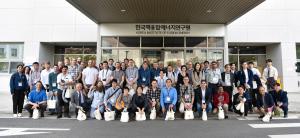Aligning technology and physics
ITER, like other fusion devices, will rely on a mix of external heating technologies to bring the plasma to the temperature necessary for fusion. At a five-day workshop in Daejeon, South Korea, world specialists focused on one of the principal techniques: heating from electron cyclotron waves.
Electron cyclotron (EC) waves will play a pivotal role in ITER, and in future fusion reactors in general, by providing reliable and efficient heating of the burning plasma. The development of high-power sources and robust equipment for wave transmission and injection is key for ITER to achieve its goals. What's more, an upgrade of the electron cyclotron resonance system (ECRH) before the beginning of the scientific research operations has recently been decided at ITER—with significant additional electron cyclotron resonance heating power required as part of a modified mix of heating and current drive power.
The 22nd Workshop on Electron Cyclotron Emission (ECE) and Electron Resonance Heating (ECRH)—held in Daejeon, South Korea, from 22 to 26 April, focused on this topic, bringing together more than 80 scientists working worldwide on electron cyclotron theory, experiments, diagnostics and technology.
The event was primarily organized by Ulsan National Institute of Science and Technology (UNIST) and the Korean Institute of Electromagnetic Engineering and Science (KIEES) in South Korea, led by local organizing chairs Professor EunMi Choi, Professor Gunsu Yun, and Dr. Sonjong Wang. The scientific program was coordinated by an international committee chaired by Professor Emanuele Poli and featured 13 invited talks, 30 contributed oral presentations spread across 13 sessions, and a 3-hour poster session that facilitated active discussions. Additionally, the program included a tour of the KSTAR tokamak.
Contributions by ITER scientists and on ITER-related topic represented a strong focus of the workshop along with recent updates on various devices such as DIII-D, ASDEX Upgrade, KSTAR, and W7-X, and highlighted the importance of integrated development that aligns technological needs and physics applications.



